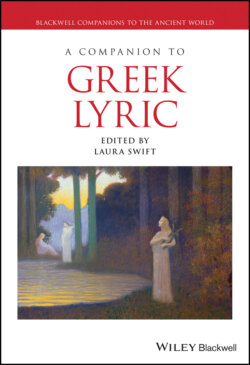Читать книгу A Companion to Greek Lyric - Группа авторов - Страница 80
Dialect and Meter
ОглавлениеLyric poetry admits a variety of dialectal forms: depending on the poet, a poem’s genre, or its meter, Doric, Aeolic, or Ionic features might predominate over one another. The emergence of a lyric koinē, furthermore, means that the relationship between a poet’s vernacular and Kunstsprache is neither obvious nor straightforward (see de Kreij, this volume). For the papyrologist’s purposes, dialect is a particularly important basis for attribution: in the case of the first fragment of P.Oxy. 35.2735, for example, dialect and Doric accentuation alone are sufficient to whittle the authorial possibilities to two—Stesichorus or Ibycus (Finglass 2017c: 21) (Figure 7.15).
Figure 7.14 P.Oxy. 21.2295, frr. 18 and 28 (= Alcaeus frr. 157 and 167), with marginalia, including metrical observations (fr. 18.3) and a variant reading (fr. 18.8) from the grammarian Apion. (Courtesy of The Egypt Exploration Society and the University of Oxford Imaging Papyri Project.)
Figure 7.15 P.Oxy. 35.2735, fr. 1 (= Ibycus fr. 282A), with Doric accentuation. (Courtesy of The Egypt Exploration Society and the University of Oxford Imaging Papyri Project.)
Conclusions regarding dialect are often buttressed or refined by analyses of diction and of meter, but certainty on all fronts is uncommon. The combination of Ionic dialect and meter in P.Oxy. 22.2321 (Figure 7.16), for example, means that ascription to Anacreon “will hardly be disputed” (in the words of its editor, Edgar Lobel), even though there is no exact parallel in his extant oeuvre for its particular metrical arrangement—three-line stanzas in varieties of anaclastic ionics. The previously mentioned supplements to P.Fouad inv. 239, similarly, build upon that fragment’s Aeolic dialect by way of a metrical hypothesis, namely, that the poem’s meter was a glyconic with dactylic expansion (gl2d). Since the second book of the Alexandrian edition of Sappho consisted of poems in this meter, and since the line-beginnings in the papyrus’ second column are also consistent with it, the hypothesis was especially attractive until the appearance of an asterisk rendered the case for Sappho unlikely (de Kreij 2022). And lastly, a recent analysis of P.Oxy. 32.2624 suggests that at least some of its 56 fragments derive from a fifth-century work of choral lyric in dactylo-epitrite, more likely to have been composed by Simonides than Pindar (Ucciardello 2017).
Figure 7.16 P.Oxy. 22.2321, fr. 1 (= Anacreon fr. 346), with accents. (Courtesy of The Egypt Exploration Society and the University of Oxford Imaging Papyri Project.)
In truth, part of what makes the study of lyric papyri so exciting is that expectations are regularly defied: because so little survives, new data are almost inevitably surprising. The publication of the “new” Archilochus elegy on Telephus (= P.Oxy. 69.4708) in 2005 was revolutionary because of that poem’s mythological narrative, something not previously found in early elegy; that of the “new” Simonides elegy on Plataea (= P.Oxy. 22.2327 + 59.3965) in 1992, similarly, bore witness to the possibility of elegy on the subject of recent history. But these are relatively tame compared to cases such as P.Dryton 50 (see Morrison, this volume), an extensive lyrical monologue from the Hellenistic period (also known as the fragmentum Grenfellianum). Its frequently prosaic language, for one thing, is at odds with its metrical complexity: the lyrics are of a polymetric and non-strophic type characteristic of late Classical “New Music” (LeVen, this volume). They are also rife with dochmiacs, a colon (= metrical unit) whose extensive use had previously been thought peculiar to the lyrics of Classical tragedy and which appears for the last time in this fragment. It remains a work largely without parallel, though the presence of a loan dating to 174 BC on the papyrus’ obverse is consistent with the hypothesis that it is a Hellenistic composition.
As with that of dialect, the analysis of meter can be daunting, technical work (Battezzato 2009; D’Angour, this volume). For papyri, the matter is complicated not only by the fragmentary state of most texts but also by the fact that, prior to the second century BC, lyric poetry was transcribed as prose, i.e., without any indication of metrical division. The aforementioned Sappho ostracon (PSI 13.1300, III/II BC, Figure 7.6), P.Dryton 50 (circa 174 BC), and the Berlin fragment of Timotheus (P.Berol. inv. 9875, IV BC, Figure 7.17) are all examples of early texts of lyric that lack a meaningful colometry: such papyri place the onus of metrical analysis squarely on their editors. In the first case, the result is the familiar Sapphic stanza, but the latter two poems, by contrast, are vastly more complicated for their polymetry, with an array of cola to identify and distinguish. Luckily, such a layout is the exception rather than the rule: the division of lyric into cola is often ascribed to the scholar Aristophanes of Byzantium (circa 255–180 BC), and from the second century BC on, poetry divided colometrically into stanzas and triads is the norm (Barbantani 2009: 301).
Figure 7.17 P. Berol. inv. 9875 (= Timotheus fr. 791). (bpk Bildagentur / Aegyptisches Museum und Papyrussammlung, Staatliche Museen, Berlin, Germany / Photo: Sandra Steiß / Art Resource, NY.)
